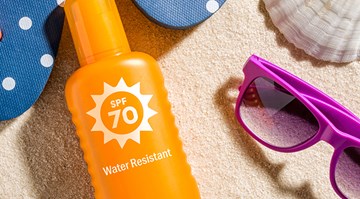Summer is right around the corner, and many of us will soon be spending more time in the sun. But that can increase the chance of skin cancer, the most common cancer in the U.S. One in five Americans will develop it at some time. But the good news is: you can prevent it! Here are some tips:
- Seek the shade.
- Stay out of the sun as much as possible from 10 a.m. to 4 p.m., the peak hours for UVB rays.
- Cover up.
- This includes wearing a wide-brimmed hat and UV-blocking sunglasses to protect your face, eyes, head, ears and neck. Clothes made from tightly woven fabric offer the best protection. A wet T-shirt offers much less UV protection than a dry one. And darker colors may offer more protection than lighter ones.
- Don’t burn.
- The sun’s UV rays can damage exposed skin in as little as 15 minutes. Yet it can take as long as 12 hours for skin to show the full effect.
- Avoid tanning and UV tanning booths.
- UV radiation from tanning machines can cause skin cancers like melanoma, the deadliest type. People who begin indoor tanning during their teen years or early adulthood have a higher risk of melanoma.
- Use a UVA/UVB sunscreen every day.
- Use a broad-spectrum UVA/UVB sunscreen to protect against both types of UV rays, with a Sun Protection Factor (SPF) of 15 or higher. Some cosmetics include SPF.
- For extended timed outdoors, use a water-resistant, broad-spectrum sunscreen with SPF 30 or higher.
- Apply at least 1 ounce (enough to fill a shot glass) 15 minutes before you go outside. Reapply every 80 minutes, more often when swimming or sweating.
- Be a good role model for sun protection. Teach your children to take care of their skin.
- You still need protection in cool or cloudy weather. UV rays, not the temperature, do the damage.
- Keep kids protected.
- Severe sunburns in childhood may increase the risk of melanoma. Children should be carefully protected from the sun.
- Examine your skin.
- Do a head-to-toe self-exam every month.
- Follow with a doctor’s visit at least once a year -- or any time you notice a change in your skin.
Other things to know:
- Tanned skin is damaged skin. Any change in skin color after time outside—whether sunburn or suntan—indicates damage from UV rays.
- It is estimated that nearly 9,500 people in the U.S. are diagnosed with skin cancer every year.
Learn more:
https://www.cdc.gov/cancer/skin/
https://www.cdc.gov/cancer/skin/basic_info/children.htm






